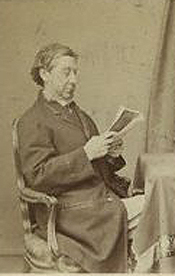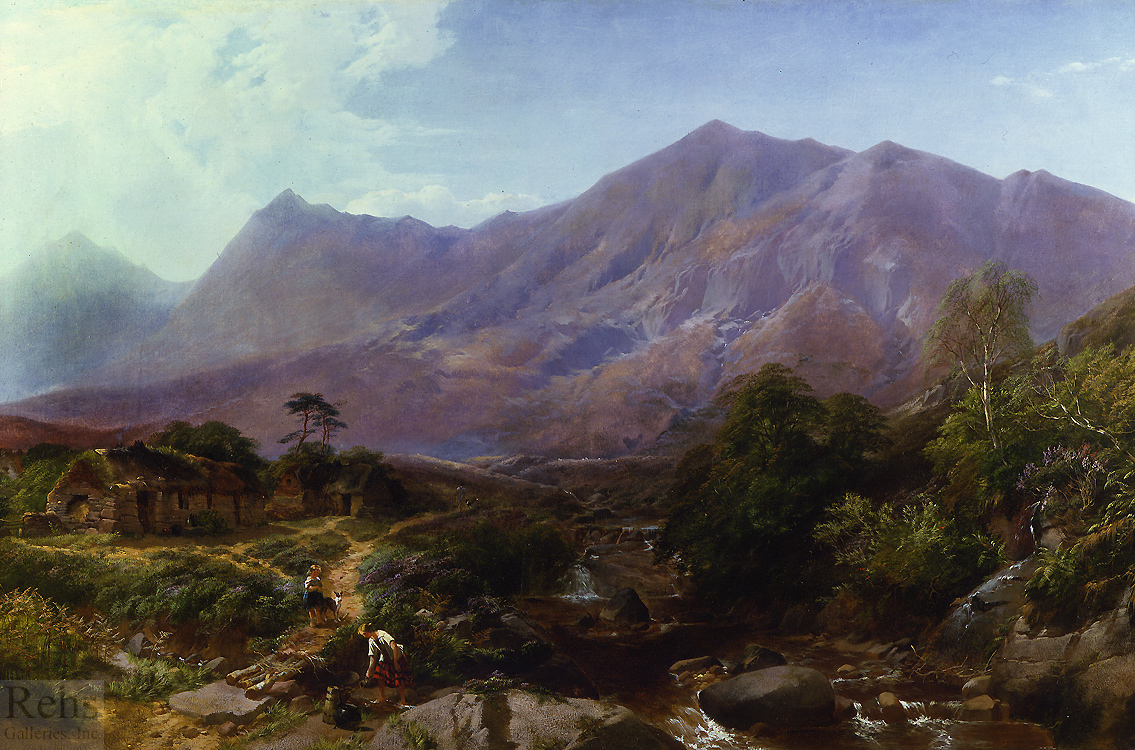Henry Jutsum
(1816 - 1869)
Fetching Water
Oil on canvas
26 x 40 inches
Signed and dated '56
BIOGRAPHY - Henry Jutsum (1816 - 1869)

A lifelong Londoner, Henry Jutsum was born in 1816 shortly after the British defeated Napoleon for the last time and assumed a renewed leadership position in the world. As a pioneering industrialized nation, Britain’s economy in the early nineteenth century was significantly more stable than continental Europe’s war-torn regions, many of which were still primarily agrarian economies with little industrial technology. For the British arts community, this relative stability encouraged a measured pace of experimentation within the framework of the existing academic standards.
Jutsum began his artistic education in Devon, where he may have had family, but then returned to Kensington in London to continue his studies. By age 14, in 1830, he apprenticed to the Norwich School painter, James Stark, who had just returned to London after a ten-year stay in Norfolk. At this time, Stark was midway through his publication on The Scenery of the Rivers of Norfolk, which would be completed in 1834; his illustrations for this project reflect the strong topographical emphasis of the Norwich School, and no doubt provided an important influence on the impressionable Jutsum.
British landscape painting in the 1830s was at the peak of its influence—an especially propitious time for a young artist to establish his reputation in the field. With Stark’s guidance, Julsum would have absorbed the ideas and principles of the Norwich School, one of the first regional landscape painting groups in Europe. Led by John Crome and John Sell Cotman, the Society held annual exhibitions from 1805 to1833, emphasizing the importance of direct observation of nature. Like their better known colleague, John Constable, the Norwich School painters developed their images outdoors in front of the motifs they hoped to capture on canvas. The most important influences came not from the Italian and French classical traditions, but from the baroque schools of Dutch and Flemish landscapists, particularly Meindert Hobbema whose paintings were collected by many of the wealthy aristocrats and merchants of Norfolk.
Although much of his painting remains undated, the stylistic progression of Jutsum’s work echoes the development of English landscape painting. Works such as A Hunting Party appears to be an early attempt, reminiscent of eighteenth century pastorals with small figures in aristocratic costume and gauzy, Gainsborough style trees. A later work from 1845, The River Kidd Near Knaresborough, or the undated Bridge with Cattle, reveal a much more sophisticated hand; here Jutsum concentrates on the tangible features of the landscapes with scientifically precise cloud formations and careful attention to botanical accuracy. These features are characteristic of his work throughout his mature career, whether in oil paintings or in watercolors. As Patrick Noon notes in Crossing the Channel, the naturalism of this generation of British landscape painters “called for a dynamic interaction between an individual mind and an observable but protean world. It was at once more scientific and more sensate. While it was the duty of the modern artist to mirror the natural world, the poetry of landscape painting as a high art resided more significantly in the artist’s ability to communicate subjective impressions before those phenomena, however trivial or sublime they might be.” [i]
By the mid-1830s, Jutsum had begun to establish a reputation as a successful landscape painter. Although still quite young, he exhibited his works at the British Institution, a private art club, and presumably was able to attract the attention of the many collectors associated with that organization. At some point during this decade, he also seems to have become intensely committed to working in watercolor. The reasons for this remain unknown, but it is certainly likely that the work of John Sell Cotman, a leading member of the Norwich School, may have been an important influence.
In 1843 Jutsum was elected a member of The Associated Painters in Water-Colours, an organization founded in 1831 under the name of the New Society of Water-Colour Painters. Its goal was to provide exhibition venues for watercolorists outside the annual events at the Royal Academy, which had become too limited. As Gilbert Richard Redgrave explained in his 1905 history of watercolor painting:
The available space at the Royal Academy for water-colour drawings still remained a very limited one, and as the artists outside the ranks of the society grew in numbers and gained in influence, a time arrived when the provision of another gallery seemed to have become a matter of imperative necessity. A meeting of artists was convened and steps were taken to form a new society, " not necessarily," as we are told, " in rivalry and opposition to the existing body, but in the interests of their own art, as essential to the sale of their pictures, and indeed in self defence. [ii]
Jutsum participated in the Association for five years, working consistently in watercolor and exhibiting at the gallery at No. 38 Pall Mall. For an artist without other sources of financial support, watercolors offered several advantages. First, it was less expensive in terms of supplies, as well as an easily portable medium for a landscape painter who was often on the road in search of motifs. During the 1840s, Jutsum’s documented painting expeditions included trips to Devonshire and the Scottish Highlands, and it is likely that he traveled elsewhere in Britain as well. Second, watercolors were affordable to a larger market of potential buyers, which meant that a middle-class client who would not be able to purchase an oil painting might be tempted by a watercolor.
After 1847, Jutsum returned to oil painting as his primary mode of expression. Again, there has been no research on the reason for this change of heart, but there is documentation of his participation in the 1851 exhibition at the Royal Academy, where he displayed Devonshire Coast, an oil painting that attracted positive critical attention. Perhaps Jutsum’s painting had become sufficiently marketable to provide him with a comfortable income. His popularity with collectors is also suggested by a hand-colored engraving of an earlier work, The Noon-day Walk that was published in The Art Journal in 1858.
Jutsum’s achievements as an artist also allowed him to purchase a home in St. John’s Wood, one of London’s earliest suburbs. Developed in the 1820s as a residential district for “villa” housing, it was a very fashionable address, and a certain indicator that Jutsum was quite affluent by the 1850s. A carte-de-visite from the 1860s confirms this impression with an image of a well-dressed man seated comfortably in an elegant armchair. Henry Jutsum died in St. John’s Wood on 3 March 1869 at age 53.
Janet Whitmore, Ph.D.
Selected Museums
Government Art Collection, Department for Culture, Media and Sport, UK
Victoria and Albert Museum, London
Worcester City Museums, UK
[i] Patrick Noon, Crossing the Channel: British and French Painting in the Age of Romanticism, (London: The Minneapolis Institute of Arts in association with Tate Publishing, 2003), 197.
[ii] Gilbert Richard Redgrave, A History of Water-Colour Painting in England
'Published under the direction of the General Literature Committee' (London, Society for Promoting Christian Knowledge, 1905), 171-172.

